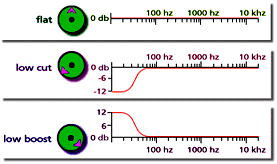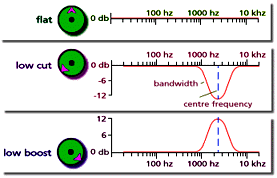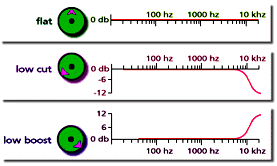| Hi/Medium/Low Equalization |
| Most mixers provide each input channel with some form of equalization. | Three areas are often provided allowing adjustment of low, medium, and high frequency regions of a sound. Each of these adjustments can be applied to either cut or boost its frequency range. | The dials usually have no effect when turned to the centre position. This is known as the "flat" position, with frequency cuts applied when turned counter clockwise and frequencies being boosted when turned clock-wise. |
| The diagrams below gives EQ knob settings and corresponding response curves for a typical low-mid-high equalizer: |
| Low
Shelf
Low frequency cuts are useful when the sound is boomy or muddy sounding, while boosting this range can add weight or warmth to a sound. |
 |
| Mid. Medium frequency boosts can be used to add emphasis to the sibilance of speech helping make it more intelligible. More sophisticated mid-range equalizers may add sweepable control of the centre frequency which can be tuned over the mid-range frequency band. Another control which may be available is a bandwidth adjustment allowing adjustment of the width of the band of frequencies affected by the equalizer. |  |
| High
Shelf
High frequency cuts can reduce noise and hiss from an incoming signal, while a boost in this region can add brilliance to the sound. |
 |